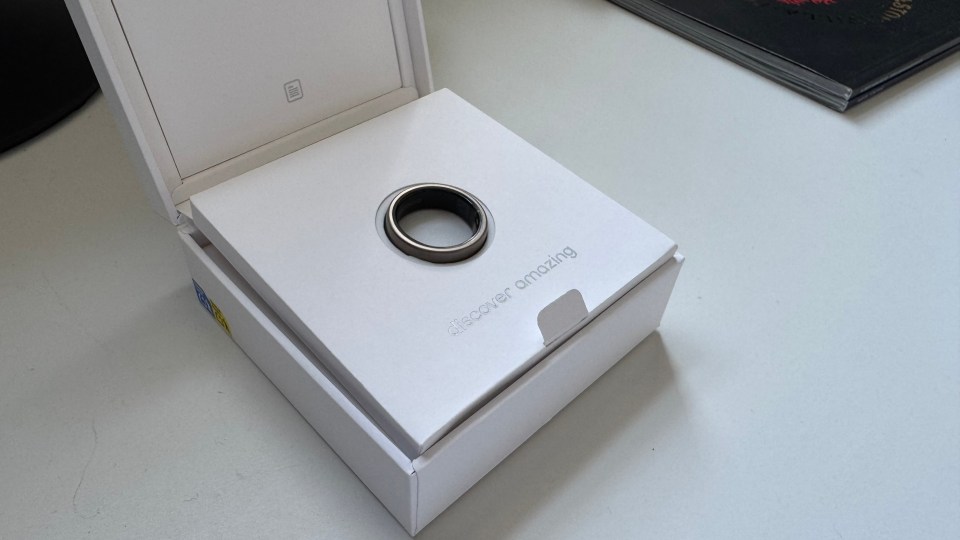From niche fitness devices to must-have gadgets, the evolution of smart rings has been something to behold.
Used to track general health, sleep, wellness and exercise, these nifty wearables are changing the tech landscape, with competition becoming more fierce each passing year.

Amazfit Helio Ring, £149.90
Entering the market in 2024, we saw Amazfit’s Helio Ring – an affordable alternative to Oura and Ultra Human devices.
To see if this ring could hold its own against the best, I got my hands on the Amazfit Helio to put it through its paces.
Keep reading to see if this budget alternative was up to the task…
How we tested
To test the Amazfit Helio Ring, I spent over two weeks with the device to see how accurately it measures my sleep, exercise and general well-being.
I wore the ring all day and night, only removing it when charging or if I was in the gym.
Paying close attention to the quality, how well it worked and how comfortable it was to wear, I gave the Amazfit Helio Ring a rating out of 5 to determine just how worthwhile it is.
Amazfit Helio Ring review: quick summary

Amazfit Helio Ring, £149.90
Pros:
- Affordable
- Looks and feels premium
- Simple but effective app interface
- Accurate sleep tracking
- Slim and lightweight
Cons:
- Limited sizes available
- Only one choice of colour
- Limited workout modes
- Average battery life (4 days)
Rating: 4/5
As one of the more affordable options in the fitness ring space, I was looking forward to testing the Amazfit Helio Ring.
The sizes available for this ring are few and far between, meaning I had to settle for a size 12 despite being a size 11.
Sizing aside, the ring itself felt and looked the part with a high-quality finish and construction.
Within minutes of opening the box, I was set up on Amazfit’s dedicated app Zapp, and the ring started to collate data.
The app interface is extremely easy to use, and while it might not be as flashy or as detailed as the Ultrahuman, it was very straightforward with its insights and suggestions.
I was particularly impressed by the sleep tracking feature on the app and found the daily sleep insights in line with how my body was feeling.
One of the ring’s shortcomings was using the workout mode, as there were only four choices of exercise to pick from.
Because of this, I couldn’t record my indoor cycling and I never wear rings in the weight room, so there were gaps in the data.
The Amazfit Helio Ring lasted around four days on average between charges, meaning it was at an acceptable level, but nothing too impressive.
Despite these minor limitations, I can truly recommend the Amazfit Helio to anyone looking for a budget alternative to some of the bigger names in the industry.
With a sleek design, accurate tracking and accessible levels of data, the Amazfit Helio Ring delivers the perfect entry point for anyone looking to dip their toe into the evolving world of tech wearables.
Amazfit Helio Ring review: full review

Amazfit Helio Ring, £149.90
Having already tested Ultrahuman’s Ring Air, I was keen to see whether Amazfit’s Helio device could compete.
At around half the price of both Oura and Ultrahuman, the Amazfit Helio landed on the market in early 2024 and has since become a budget alternative for those looking to join the smart ring club.
Before I got my hands on this ring, I first had to choose from one of three available sizes.
My ring size is 11 but I had to opt for size 12, despite my apprehensions, the ring did fit, though I was conscious of it falling off my finger for the first three days of wear.
On first impressions, the ring appeared far more silver than its bronzed and beige appearance shown in the product images, but truthfully, I didn’t mind at all.
The ring looked and felt premium, and I was quite surprised by its lack of weight (4 grams, to be precise).
Connecting to the app was simple too. Within minutes, I was browsing the interface and the data began to trickle in.
The app displays data using three key pillars: readiness, sleep, and exertion; with each offering a straightforward daily overview.
The data itself isn’t quite as in-depth as that of some of its competitors, but at the same time, it is far more accessible and easier to understand for the average consumer.

Amazfit Helio Ring, £149.90
With just a glance at the homepage, you’re presented with readiness, sleep, and exertion scores, as well as HRV (heart rate variability) and RHR (resting heart rate).
For those seeking further insights or explanations, the app has a distinctive focus on AI coaching.
Using the “Ask Aura” function, I discovered what affects my sleep duration, asked sports-related questions, and even adjusted music based on my relaxation score.
Truthfully, I couldn’t see myself using these features regularly, but for those with an affinity for such things, they could prove helpful.
The workout mode is limited to just four options: running, walking, cycling, or treadmill, with the first three activities tracked by GPS.
This meant I couldn’t even track my indoor Zwift workout properly, making the mode useless for users unless they’re runners or cycle outdoors.
Admittedly, it’s quite difficult to find any major issues with the Amazfit Helio besides the limited sizing and colour options.
But I did feel the workout mode left a lot to be desired.
With all that said, I’d absolutely consider using the Amazfit Helio Ring in the future.
The sleep, recovery, and health insights are straightforward, and the ring offers a no-frills experience that is more than worthy of its affordable price point.
Amazfit Helio Ring: the verdict
While the Amazfit Helio Ring was a letdown in regard to its limited sizing options, colours and workout modes, I would still thoroughly recommend this product for anyone looking for a budget fitness tracking ring.
I was really impressed by the sleep, health and recovery insights. The app didn’t overcomplicate anything and was extremely easy to follow.
In addition to the app, I really enjoyed the build quality and feel of the ring.
For less than £150, you truly get your money’s worth with the Amazfit Helio.

Amazfit Helio Ring, £149.90
Amazfit Helio Ring FAQs
Navigate the FAQs by clicking the links below.
- Can you wear the Amazfit ring on any finger?
- Does the Amazfit smart ring measure blood pressure?
- Is the Amazfit Helio ring waterproof?
- Can you pay with smart rings?
- How often will you need to charge the Amazfit Helio ring?
Can you wear the Amazfit ring on any finger?
Technically, yes you can, but it isn’t advised.
To get the most out of your ring, Amazfit recommends you wear it on either your index or middle finger.
This is for optimal tracking and sensor function. The ring also has a small vertical line on the exterior that indicates where the sensors are located.
I found the ring to be the most comfortable when I wore it on the index finger of my non-dominant hand, and I didn’t seem to have any issues with connectivity.
Does the Amazfit smart ring measure blood pressure?
No, the Amazfit smart ring does not measure blood pressure.
Instead, it measures blood oxygen saturation levels. Measured as Sp02, blood oxygen saturation refers to the amount of haemoglobin in your blood that is carrying oxygen.
A healthy range is typically between 95% – 100%.
Blood pressure (which isn’t measured), is the force which blood uses to move itself through arteries.
Is the Amazfit Helio ring waterproof?
The Amazfit Helio ring isn’t waterproof, but rather, water resistant.
The ring has a 10 ATM water resistance rating, which essentially means the ring can withstand a pressure equivalent to 100 meters.
This means the Amazfit Helio Ring will be suitable for the following activities:
- Swimming
- Hand washing
- Bathing
- Snorkelling
- Showering
- General water activities
I personally wore my ring in the shower, sauna, steam room and when washing my hands and had no issues whatsoever with the water resistance.
Can you pay with smart rings?
Typically, health-focused smart rings like Amazfit do not feature NFC technology, meaning you won’t be able to use your smart ring as a contactless payment.
Certain products on the market allow for this, but the Amazfit Helio is not one of them.
How often will you need to charge the Amazfit Helio ring?
The Amazfit Helio ring has around four days of battery life, meaning you will need to charge it after three to four days of constant wear.
I personally found the battery of the Amazfit Helio ring to be quite consistent and I frequently got around 4 days’ worth of charge even with the emotion change detect feature enabled.
For more sports, health and fitness content and buying guides, check out our dedicated talkSPORT shopping hub.



